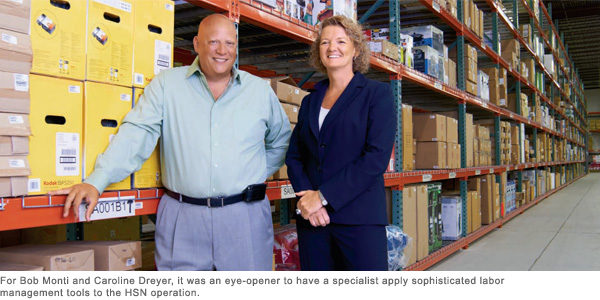HSN makes a good buy

For multi-channel retailers competing in the cutthroat direct-to-consumer market, the key to success lies in creating a positive delivery experience for the customer. Make deliveries cheap, fast, and reliable, and the retailer is one step ahead of the game.
That's not as simple as it might sound. Mastering the delivery challenge requires not only getting the transportation part right, but also the fulfillment part. And as Bob Monti, senior vice president of supply chain operations for St. Petersburg, Fla.-based Home Shopping Network, will tell you, labor management software and process improvements have a lot to do with it as well.
Founded in 1977 as the nation's first television network devoted to shopping, the company now known as HSN has built a $3 billion-a-year brand through its ubiquitous presence on the tube and the Web. It broadcasts 364 days a year, reaches 96 million homes, and represents one of the top 10 sites for e-commerce traffic.
Behind the smiles of the celebrities and the almost-famous hawking virtually anything imaginable beats the heart of the HSN operation: a fulfillment network consisting of three distribution centers, located in Roanoke, Va.; Piney Flats, Tenn.; and Fontana, Calif. The DCs, which combined total more than 1 million square feet of space, are overseen by the no-nonsense Monti.
Monti is only as demanding as the environment he works in. HSN guarantees deliveries within 10 calendar days of a customer's order, but nearly 70 percent of its deliveries are made within six calendar days. At the same time, HSN, like its rivals, has been aggressively pushing such customer promotions as free or reduced-cost shipping and handling (S&H) to boost its value proposition. While this has pleased HSN's customers, it puts pressure on Monti and his staff to continue to drive out costs while improving its fulfillment and delivery standards.
Because HSN's top brass plans to expand its shipping and handling promotional efforts—and given that S&H accounts for two-thirds of his operation's expenses—Monti doesn't expect his job to get any easier.
A push to slash labor costs
With the pressure to contain costs mounting, in mid-2008, Monti and his chief assistant, Caroline Dreyer, vice president of fulfillment operations, decided it was time to act. They began exploring ways to improve efficiencies in HSN's three DCs to reduce operating costs and free up cash flow so HSN could fund more delivery-related promotions.
They focused on a plan to improve DC worker productivity and slash what Monti calls "variable labor spend." The goal was an 18-percent improvement in productivity and a 10-percent reduction in operating expenses.
Given the fulfillment-heavy nature of HSN's work, Monti and Dreyer believed the company was further along than most in understanding the nuances of DC work-force issues. However, because they didn't have automated productivity tools or sophisticated engineered labor standards to measure workplace output, they were forced to measure present and future results by past performance metrics. While this yielded reasonably accurate data, Monti felt it didn't give HSN the maximum visibility needed to unearth even greater efficiencies and cost-savings.
Monti proposed to engage TZA, a Long Grove, Ill.-based consultancy specializing in the design and implementation of labor-management software and supporting it with a deep knowledge of best practices and engineered standards. But consummating the marriage wasn't easy. HSN's executive suite, in hunkered-down mode as the financial crisis and recession took hold, twice rejected the proposal. On the third try, in January 2009 with the downturn in full fury, it was green-lighted.
A 20-percent boost in productivity
The project took two years to complete and required a major change in how the DCs and their workers functioned. But when the dust settled, the results surprised even the hard-to-impress Monti. The operation met its operational savings goals, and worker productivity rose by more than 20 percent, exceeding HSN's original objectives. HSN recouped its entire investment in less than 15 months, according to Monti.
Meanwhile, the savings enabled Monti's unit to help HSN defray the rising cost of shipping & handling-related promotions it considered so critical to building customer loyalty.
As part of the project, HSN installed TZA's labor management software, a program that runs on a stand-alone basis but functions in close concert with the company's warehouse management system. For the first time, HSN had the visibility to track DC performance at the individual employee level and to reward workers—as well as hold them accountable—for meeting the engineered standards. In addition, the program helped HSN determine best practices for each of the operation's functional areas. Through it, the company was able to eliminate steps impacting its product returns function, through which 6.5 million units move per year.
To Monti and Dreyer, seasoned logisticians who felt they already ran an efficient shop, it was an eye-opener to have a specialist in DC work-force issues apply high-level labor standards to the HSN operation. "You don't know what you don't know until you put these tools in and run with them," Monti said.
Monti said that without the TZA toolkit, "we couldn't have achieved this level of improvement." Leveraging the visibility provided by TZA's labor management software and applying it to the engineered labor standards, "made all the difference in the world for us," he added.
$10 million in transportation savings
With the fulfillment project behind them, Monti and Dreyer turned to revamping HSN's delivery network. For years, UPS Inc. had been HSN's main shipping vendor, mostly managing end-to-end deliveries from the three DCs to the consumer. But Monti and Dreyer decided to tap into a joint venture between UPS and the U.S. Postal Service (USPS), under which UPS hands off HSN's packages to the USPS system for "last-mile" deliveries to any U.S. address.
By relying more heavily on the lower-cost postal network, HSN cut its annualized shipping spend by $10 million. It also developed a broad-based logistics program with UPS that included, among other things, volume-based incentives for customers and an enhanced returns solution.
Monti acknowledges that expanding HSN's use of the USPS system and introducing a physical exchange of packages between the two carriers "slowed down" the retailer's delivery schedules by half a day, on average. However, he said that the newly streamlined picking and packing operations allow the DCs to push packages out the door faster, offsetting the impact of the slower delivery timetables.
Monetary incentives
As for the transition, Monti and Dreyer said many members of the DC work force were apprehensive about what the new efficiency standards would mean to them. To quell uncertainty and motivate workers, they instituted a plan to give workers half of the proceeds from productivity gains above a certain baseline called for by the engineering standards implemented by TZA.
About 70 percent of the workers have achieved more than what Monti termed "baseline productivity" metrics and have pocketed what can be considered performance bonuses. Monti and Dreyer said DC employee turnover is currently at an all-time low.
Based on his conversations with TZA, Monti believes companies in and out of the multi-channel retailing category can achieve productivity gains of up to 30 percent through implementing a mix of DC labor-management software and processes. HSN's improvements were lower on a percentage scale, he said, because the company has already worked for years to improve labor productivity and was not starting from scratch.
C. Dwight Klappich, vice president of research at consultancy Gartner Inc., said the use of labor-management software and engineering standards to measure DC worker performance is gaining momentum as companies focus more on productivity improvements than cost-cutting to drive efficiencies. The declining costs of software implementation and ongoing support will further boost demand as the tools become more affordable to a wider customer base, he added.
Klappich said Gartner's research shows that firms have "already slashed costs about as far as brute force will allow, so now they need tools like [labor-management software] to help drive efficiency, to keep costs where they are, and lower costs more intelligently wherever possible." The consultant added that labor-management software is an area of "potential low-hanging fruit, and typically these investments have strong financial returns" for its users.
Comments like those are music to the ears of companies like TZA, which has positioned itself as both software vendor and consultant to capitalize on what it sees as a wide-open market opportunity. "The labor-management software market is today where the WMS market was 10 years ago," said Steve Simmerman, the consultancy's senior vice president of business development.
Related Articles

Copyright ©2024. All Rights ReservedDesign, CMS, Hosting & Web Development :: ePublishing